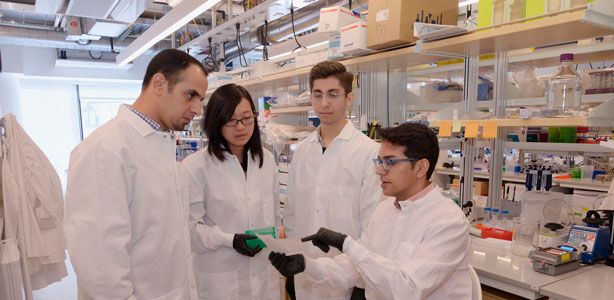A study published today in Science, in which researchers used thousands of CRISPRs — new gene editing tools that have been applied to everything from plants to humans — to mutate noncoding regions of the human genome may offer new treatment options to patients with advanced melanoma and other cancers.
Often referred to in the popular press as “junk DNA” or “dark matter of the genome,” the noncoding genome is a promising new frontier in genomics that has been implicated in many common diseases. As its name implies, noncoding DNA is not involved in the encoding of protein sequences that carry out many of the tasks inside a cell. Rather the noncoding genome acts, in part, as a control knob for regulating the production of proteins and its role in disease is less well understood than that of protein-coding genes.
Instead of targeting a single protein or gene, the authors looked over these noncoding regions to understand how tumors can keep growing even when patients are given potent chemotherapies. The paper, “High-resolution interrogation of functional elements in the noncoding genome,” identifies specific chunks of the noncoding genome responsible for treatment-resistant melanoma growth. Its co-lead author, Neville Sanjana, PhD, a core faculty member at the New York Genome Center and Assistant Professor of Biology at NYU, conducted the research when he was at the Broad Institute and the Massachusetts Institute of Technology. Dr. Sanjana noted, “While scientists now have a good understanding of the role that protein-coding genes play in our genetic makeup, much less is known about the function of noncoding DNA–even though it makes up over 98% of the human genome. ”
To create thousands of mutations in the noncoding genome, the study harnessed a recent gene editing technique called CRISPR, which is short for Clustered Regularly Interspaced Short Palindromic Repeats. Over the past few years, CRISPR has revolutionized biomedical science by making it easier for scientists to modify the DNA inside a cell. In its natural context, CRISPR functions as an adaptive immune system for microbes, but has found many applications in genome engineering for disease research and gene therapy. In this study, another key feature of CRISPR was on display: The ability to quickly engineer thousands of CRISPRs to target many different parts of the genome. Because CRISPR targets specific sequences in the genome using a short guide, it can be easily programmed to target many different locations within the human genome. Such precise, programmable editing is impressive, as the human genome consists of more than three billion letters of DNA (equivalent to approximately 6,000 average-length novels).
The study’s authors, which include scientists at the Massachusetts Institute of Technology and at the Broad Institute, were able to use the large library of CRISPRs to edit certain noncoding portions of the human genome and identify functional elements related to cancer progression and gene regulation. They found that many noncoding DNA regions serve a critical role in the regulation of protein-coding genes, such as when they are turned on and how much protein is produced.
All cancers can mutate and become resistant to drug therapy, but melanoma and lung cancer tend to have more mutations than virtually any other type of cancer. Especially for these patients, there is a pressing need to discover not only what kind of mutations create the disease, but what mutations cause resistance to common drugs used in the clinic. For example, many melanoma patients receive a drug called vemurafenib as part of their treatment. The study’s authors determined which noncoding regions near key genes can be mutated to make the cancer resistant to vemurafenib. The emerging findings from noncoding CRISPR screens and whole genome sequencing emphasize the potential for mutations outside of protein-coding regions to contribute to drug resistance by altering nearby gene expression.
In the Science study, researchers screened almost 1 million bases of DNA surrounding three different genes to uncover functional genome elements relevant to drug resistance in melanoma. “We took a melanoma cell line and imposed on it through gene editing many different mutations– in effect creating thousands of different mutations within these noncoding regions of the DNA,” said Dr. Sanjana. “The data produced was as if we took samples from a million melanoma patients. But instead of the enormous effort it would take to collect a million melanoma samples, we used CRISPR to create it in our lab. Then we looked at the effect on drug resistance.”
The libraries of many CRISPRs allows a single investigator to generate a huge diversity of mutations that can then be tested for virtually any disease where there is clear readout of the disease. In Dr. Sanjana’s study, researchers tested which mutations led to resistance to drugs like vemurafenib that would normally kill melanoma cells. There was a very high validation rate of mutations identified through the high-throughput CRISPR screens: 96% of the mutations were validated when tested individually.
According to Dr. Sanjana, “Think about the classic cartoon of the man who lost his keys but only looks for them under a streetlamp because the light is better there. By limiting your search to only where the lighting is good, you risk missing something significant in other places. By casting a wider net and looking everywhere throughout the noncoding DNA regions– not just where we thought mutations where likely to be–we uncovered many more cancer-causing mutations, and mutations that made these cancer cells resistant to a drug or to immunotherapy. This is why we’re so excited about applying CRISPR to identify key regions of the noncoding genome.”
The Sanjana Lab at the New York Genome Center is continuing to delve into the genetic modulators of cancer and develop new gene editing technologies for applications in a variety of diseases like cancer and autism.
